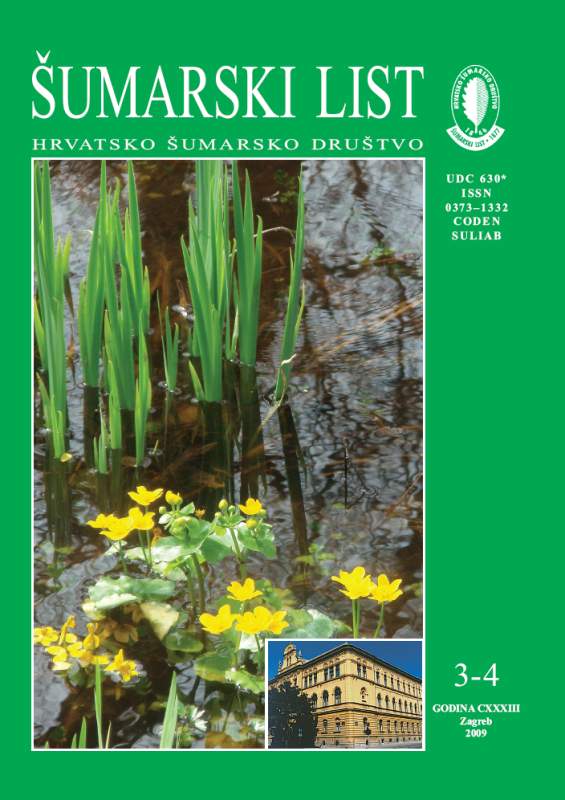
broj: 3-4/2009
pdf (5,7 MB) |
|
||||||||||||||
| RIJEČ GLAVNOGA UREDNIKA | ||
| Branimir Prpić | ||
| ON THE RELATIONSHIP BETWEEN FORESTRY AND OFFICIAL NATURE PROTECTION pdf HR EN | 120 | |
| IZVORNI ZNANSTVENI ČLANCI | ||
| Topić,V., L. Butorac, Z. Đurđević, B. Kekelić, G. Jelić | UDK 630* 232.3 (001) Cupressus sempervirens var. pyramidalis Nyman | |
| Effect of Container Type on Growth and Developtment of Seedlings of Common Cypress (Cupressus sempervirens var. pyramidalis Nyman) in Nurseriers and Forest Cultures pdf HR EN | 121 | |
| Anić,I., J. Vukelić, S. Mikac, D. Bakšić, D. Ugarković | UDK 630* 181.2 (001) Abies alba Mill. | |
| Effects of Global Climate Change on the Ecological Niche of Silver Fir(Abies albaMill.) in Croatia pdf HR EN | 135 | |
| Klobučar,D., R. Pernar | UDK 630* 585 (001) | |
| Artificial Neural Networks in the Estimation of Stand Density from Cyclic Recordings pdf HR EN | 145 | |
| Pernek,M., D. Matošević | UDK 630* 453 (001) Obolodiplosis robiniae | |
| Black Locust Gall Midge(Obolodiplosis robiniae), New Pest on Black Locust Trees and first Record of ParasitoidPlatygaster robinaein Croatia pdf HR EN | 157 | |
| Summary: Black locust gall midge (Obolodiplosis robiniae) (Diptera: Cecidomyiidae) is the most recent invasive species in Europe originating, like its host plant, from North America. It started its quick spread in Europe in 2003 from the Veneto region in Italy where it was first found. Platygaster robiniae( Hymenoptera: Platygastridae), parasitoid of the midge was first described as species in 2008. In the researches of the black locust gall midge only one record was given for Croatia (in 2006) but without details. The aim of this research was to record the distribution, biology, parasitoids and damages of this newly introduced insect species in Croatia. The presence of black locust gall midge was recorded by inspection of black locust leaves on the following localities: the greater surrounding of Zagreb, Jastrebarsko, northwestern (Đurmanec, Lepoglava, Ivanec), submediterranean (island Krk) and mediterranean (surrounding of Zadar) part of Croatia (Table 1). The presence of larvae and parasiotids in galls was researched on the sites in Zagreb. On 9 July 2008 a sample of 20 black locust leaves was taken from 3 trees and analised. Galls (Figure 1) with white (Figure 2) and yellow larvae (Figure 3) were found on the leaves. White larvae are young and yellow older instars. In the sample of 20 leaves i.e. 251 leaflets of black locust 599 galls were found which is 2,3 galls on average per leaflet. Total number of larvae was 1183 or 2 larvae on average per gall, out of which yellow larve (916) were numerous than white (82) (Table 2). Parasitised larve (Figure 4) and cocoons of parasitoidPlatygaster robiniae(Figure 5) were found in galls. The percentage of parasitism of black locust gall midge in the sample was 15,6 % (Table 2). The black locust gall midge can be cosidered as a new invasive species in Europe as well as in Croatia. The midge was very probably introduced to Europe with planting material and its main vectors of dispersal in Europe were black locust ornamental plants trade and intensive international vehicle transport. The dispersal in Croatia had two main entries: from Slovenia and Hungary for the continental part and from Italy for the Mediterranean part. The observations of the black locus midge biology in the northwestern Croatia in 2008 have not shown the development of new generation after July. The last larvae in galls were found on 9 July. Our own observations and different data on overwintering of other researchers have shown a need for more researches of the various aspects of black locust midge biology (number of generations, overwintering). In the galls of the black locust gall midge the parasitised larvae (Figure 4) and cocoons of parasitoidPlatygaster robiniae(Figure 5) were found on all localities of research in Croatia. This is the first record of this species in Croatia. From the percentage of parasitism of 15,6 % it can be presumed that the midge is present in Croatia for several years (which confirms the record from 2006) and that the parasitoid has successfully adapted itself to the new pest. In the next year a more intensive spread of black locust gall midge in Croatia can be expected, but also a multiple rise in parasitism levels. Black locust gall midge makes distinctive damages on leaflets of black locust - galls (Figure 1). Numerous galls on leaflets influence the assimilation process and can cause premature leaf drop. The galls influence the aestethic value of black locust ornamental plants. The estimation of damages caused by the midge vary considerably in Europaean countries. Black locust is not an important forest species in Croatia so the black locust gall midge is not considered as important forest pests. Aesthetic damages can be expected on ornamental plants. Key words: black locust; damage; Diptera: Cecidomyiidae; Hymenoptera: Platygastridae; new introduction | ||
| Butorac,L., V. Topić, G. Jelić | UDK 630* 116 + 434 (001) Pinus halepensis Mill. | |
| Sufrace Runoff and Soil Loss in Burnt Stands of Aleppo Pine(Pinus halepensisMill.) Growing on Colluvial Soils pdf HR EN | 165 | |
| Vuletić,D., S. Krajter, M. Mrazek,A. Ćorić | UDK 630* 652 + 289 (001) | |
| Non Wood Forest Products and Services – Are we Using them Enough? pdf HR EN | 173 | |
| Govorčin,S., T.Sinković, R. Hrčka | UDK 630* 812 + 813 (001) Fraxinus excelsior L. | |
| Some Physical and Mechanical Properties of Recent and Heat Treated Ash– Fraxinus Excelsior L. pdf HR EN | 185 | |
| ZNANSTVENI I STRUČNI SKUPOVI | ||
| Jakovac, Hranislav | ||
| Biological-Ekological and Energetic Characteristics of Indigobush (Amorpha fructicosaL.) in Croatia PDF | 202 | |


